Monochromatic colour schemes offer a timeless and sophisticated approach to interior design. By using different shades, tints, and tones of a single colour, you can create a harmonious and visually appealing space that feels cohesive and balanced. Whether you’re aiming for a calming, minimalist look or a bold and striking statement, monochromatic colours provide flexibility and creativity in design. This guide will show you how to effortlessly incorporate monochromatic colours into your home, transforming your rooms with style and elegance.
What are monochromatic colours?
Monochromatic colours are derived from a single base hue, modified by adding varying amounts of white, black, or grey to create different shades, tints, and tones. Rather than using contrasting colours, a monochromatic palette relies on the depth and variation of a single colour family, ensuring a cohesive yet visually dynamic design. For instance, starting with a base of blue, you can create a scheme using light sky blue, mid-tone cobalt, and dark navy. This approach allows you to maintain unity while still adding interest and depth to the space.
Benefits of a monochromatic colour scheme
A monochromatic colour scheme offers several advantages that make it a popular choice in interior design:
Cohesive and harmonious look: By using variations of a single colour, you create a unified and balanced appearance throughout the space. This results in a seamless flow from one element to the next, making the room feel more organised and intentional. Easy to coordinate: Since you’re working within one colour family, it’s easier to mix and match furniture, fabrics, and decor without worrying about clashing hues. This simplicity reduces decision fatigue during the design process. Creates visual depth: Although monochromatic schemes use a single base colour, varying its shades and tones adds layers of depth and dimension to the space. The contrast between light and dark variations brings visual interest without the need for additional colours. Flexible for any style: Whether you prefer modern minimalism or traditional elegance, a monochromatic palette can be adapted to suit any design style. It works well in creating both soft, serene spaces and bold, dramatic rooms, depending on the base colour. Timeless appeal: Monochromatic designs tend to have a timeless quality, as they avoid trendy colour combinations that may quickly become outdated. This makes them a solid choice for long-term interior design. Perceived spaciousness: A monochromatic scheme can make a room appear larger and more open, as the consistent use of a single colour reduces visual barriers, allowing the eyes to move freely around the space. Choosing the right monochromatic colour scheme can set the tone for your entire space. Whether you’re looking for something serene or bold, these options offer a range of moods and styles. Let’s explore some top choices.
Soothing blue monochromatic colour scheme
A monochromatic blue colour scheme instantly evokes feelings of peace and tranquillity, making it a perfect choice for bedrooms, living rooms, or any area where relaxation is key. Light shades of blue, like sky or powder blue, create an airy, refreshing vibe, while deeper tones, such as navy or royal blue, add a sense of sophistication and calm. To enhance the effect, you can mix different textures—like a soft blue velvet sofa with crisp linen curtains—to bring depth and warmth to the space. Paired with natural elements like wood or white accents, a soothing blue palette offers a serene and timeless look.

Source: Williams Sonoma (Pinterest)
Joyful pink monochromatic colour scheme
A monochromatic pink colour scheme adds warmth and a playful touch to youSSr space. Pink can range from soft, blush tones to more vibrant shades like fuchsia or magenta, giving you the flexibility to create a mood that feels either calming or energetic. Lighter pinks, like pastel or rose, bring a sense of romance and cosiness, making them perfect for bedrooms or reading nooks. Bolder pinks can add a vibrant, fun twist to living rooms or dining areas. To balance the intensity, incorporate neutral accents such as beige or white, and use textures like velvet or silk to create a sophisticated, yet joyful atmosphere.

Source: Beautiful Home Ideas (Pinterest)
Vibrant orange monochromatic colour scheme
A monochromatic orange colour scheme introduces energy and warmth into your home, making it ideal for spaces where you want to create a lively, welcoming atmosphere. From soft peach to deep terracotta, orange offers a variety of tones that can suit different moods. Lighter shades like coral or apricot work well in kitchens or dining rooms, where they can stimulate conversation and appetite, while darker hues like burnt orange or rust can add depth and sophistication to living rooms or home offices. To keep the space balanced, pair orange tones with neutral elements like wood, beige, or cream. Incorporating natural textures like jute or rattan can further enhance the vibrant, earthy feel of an orange palette.

Source: KANAROCA (Pinterest)
Sunny yellow monochromatic colour scheme
A monochromatic yellow colour scheme brings a cheerful, uplifting vibe to your space, making it perfect for rooms where you want to feel energised and happy. Lighter yellows, like buttercream or pastel yellow, create a soft and inviting ambiance, ideal for bedrooms, nurseries, or living rooms. On the other hand, bolder shades like mustard or golden yellow can add warmth and richness to kitchens or dining areas. To prevent the space from feeling overwhelming, mix various shades of yellow with natural materials like wood or neutral tones like grey or white. Textures like linen or cotton can soften the intensity and create a welcoming, sunny space.

Source: Better Homes & Gardens (Pinterest)
Uplifting green monochromatic colour scheme
A monochromatic green colour scheme evokes a sense of calm and freshness, making it an excellent choice for creating a serene, nature-inspired environment. Lighter greens, such as mint or sage, bring a soft, airy feel to bedrooms or bathrooms, offering a soothing and rejuvenating vibe. Richer shades like emerald or olive work well in living rooms or kitchens, adding a touch of elegance and earthiness. To enhance the natural feel, pair green tones with organic elements like wooden furniture or indoor plants. Incorporating a variety of textures, such as velvet or woven fabrics, can further enrich the depth and comfort of your green monochromatic space.

Source: UpgraDesign.blog (Pinterest)
Minimalistic cream monochromatic colour scheme
A monochromatic cream colour scheme creates a sense of simplicity, elegance, and warmth, making it ideal for minimalist or contemporary spaces. Cream tones add a soft, neutral backdrop that can open up a room, giving it a light, airy feel without being too stark. This versatile colour works beautifully in living rooms, bedrooms, or even kitchens, providing a timeless foundation for various decor styles. To prevent the space from feeling too flat, introduce different textures like wool, linen, or leather, and play with subtle variations of cream, from off-white to beige, for added depth and richness. Cream pairs well with natural materials like wood, stone, or metals, giving the room a sophisticated yet cosy atmosphere.
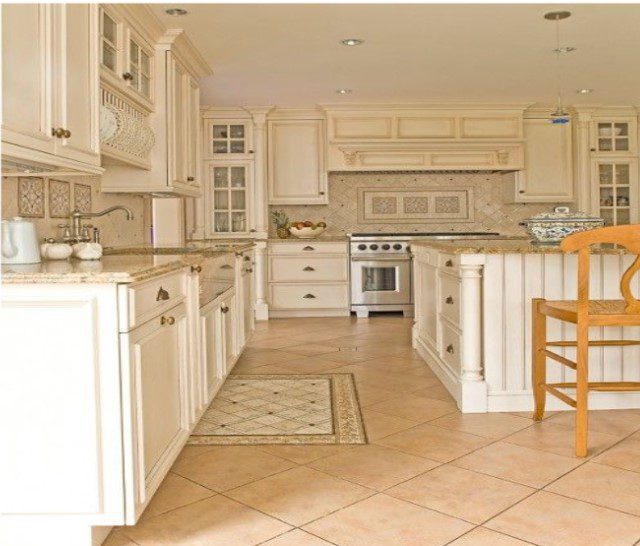
Source: Houzz (Pinterest)
Mysterious grey monochromatic colour scheme
A monochromatic grey colour scheme introduces a sense of sophistication and modernity, making it perfect for creating sleek, contemporary interiors. From soft, light greys that exude calmness to deep charcoal tones that add drama, grey offers immense versatility. In living rooms or bedrooms, lighter shades like dove grey can create a serene, peaceful atmosphere, while darker greys like slate can add depth and elegance. To avoid a cold or overly industrial feel, balance grey with different textures like velvet, silk, or wool, and incorporate metallic accents like chrome or brass to enhance its sleek appeal. Grey also pairs well with natural elements like stone or wood, adding warmth and character to the space.
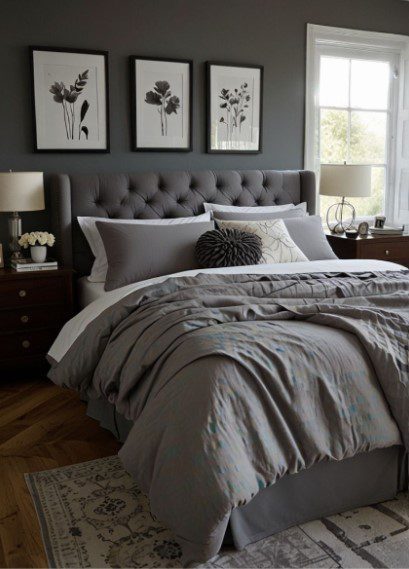
Source: GK Allum (Pinterest)
Elegant brown monochromatic colour scheme
A monochromatic brown colour scheme evokes a sense of warmth, comfort, and earthiness, making it a fantastic choice for creating inviting and cosy spaces. Ranging from light beige to rich chocolate tones, brown adds a touch of sophistication while grounding the decor. This colour works exceptionally well in living rooms, bedrooms, or studies, where a sense of relaxation and tranquillity is desired. To enrich the monochromatic palette, incorporate various shades of brown through furniture, textiles, and wall finishes. Mix materials such as leather, wood, and natural fibres to create a layered look. Adding pops of greenery with houseplants or artwork featuring organic motifs can enhance the overall aesthetic, infusing life and freshness into the warm brown tones.

Source: Luna Ezra (Pinterest)
Classic white monochromatic colour scheme
A monochromatic white co the warm brown tonelour scheme embodies purity, simplicity, and elegance, making it an ideal choice for creating bright and airy spaces. White reflects light, making rooms feel larger and more open, which is particularly beneficial for smaller areas. This versatile colour can be used in various design styles, from minimalist to classic, and works beautifully in kitchens, bathrooms, and living spaces. To avoid a sterile or flat appearance, it’s essential to play with different shades of white, such as off-white, cream, or warm white, to add depth and dimension. Incorporating textures through materials like linen, cotton, and wood can also enhance the overall look. Accessories like mirrors, metallic accents, or colourful artwork can provide visual interest, making a white monochromatic scheme feel dynamic and inviting.
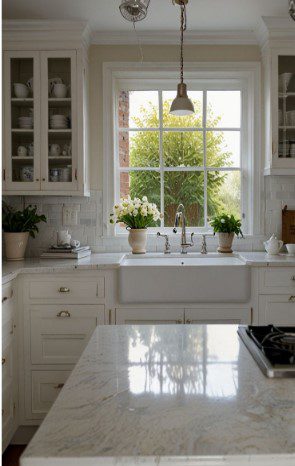
Source: Cozyco (Pinterest)
Romantic purple monochromatic colour scheme
A monochromatic purple colour scheme exudes a sense of luxury, creativity, and romance, making it a captivating choice for any space. Ranging from soft lavender to deep violet, purple can evoke a variety of moods, from calming and serene to rich and dramatic. This colour works wonderfully in bedrooms and living rooms, where it can create a soothing atmosphere or a sense of opulence. To effectively incorporate purple into your decor, consider using different shades and tones to add depth and dimension. For instance, pairing a light lavender with a darker plum can create an elegant contrast that draws the eye. Textures are also key; velvet cushions, silk curtains, and patterned rugs can enhance the richness of purple. Accents in metallic finishes, like gold or silver, can complement the purple hues and add a touch of glamour, making your space feel sophisticated and inviting.

Source: Etsy (Pinterest)
Tips to add monochromatic colours to your home like a pro
To achieve the best results while incorporating monochromatic colours into your home design, it’s important to follow some expert tips that will help you make the most of this colour scheme.
Select the right base colour
Choosing the right base colour is crucial when creating a monochromatic colour scheme, as it sets the tone for the entire space. Consider the mood you want to evoke: cool tones like blue or green can instil a sense of calm, while warm tones like red or yellow can create an inviting atmosphere. Assess the natural light in your room; lighter colours can help brighten darker spaces, while deeper hues can add warmth and cosiness to well-lit areas. Additionally, think about the existing furnishings and decor in your home; selecting a base colour that complements or contrasts with these elements can enhance the overall aesthetic. Finally, test out paint swatches or fabric samples in different lighting conditions to ensure that the chosen colour resonates well in your space throughout the day.

Source: Wayfair (Pinterest)
Start small
If you’re new to using monochromatic colours, it’s wise to start small. Begin by incorporating this colour scheme in a single area or through accent pieces before committing to larger spaces. For instance, you might begin with accessories like throw pillows, rugs, or artwork in your chosen base colour and its various shades. This approach allows you to experiment without overwhelming the room. Consider starting with a smaller room, such as a bathroom or a nook, where you can test the waters of a monochromatic palette. Once you feel comfortable with the look and how it affects the space, you can gradually expand the scheme to larger areas. This method also gives you the opportunity to assess how the colour interacts with your furnishings and lighting, helping you to refine your choices before making significant changes to your home. Starting small enables you to build confidence in your design choices and create a harmonious environment step by step.

Source: One Kindesign (Pinterest)
Pick multiple variations of the base colour
A successful monochromatic design is all about incorporating different shades, tints, and tones of the same base colour. By selecting multiple variations of your chosen hue, you can create depth, visual interest, and a sense of layering in your space. For instance, if you choose blue as your base colour, mix lighter shades like sky blue with deeper tones such as navy or cobalt. This variety prevents the space from looking flat or monotonous, giving it dimension and personality. You can use lighter shades for larger areas like walls and darker tones for furniture, accent pieces, or trim. By playing with varying intensities of your base colour, you maintain cohesiveness while adding richness and complexity to the room.

Source: Next (Pinterest)
Find the right undertones
Choosing the right undertones is key to achieving a Sharmonious monochromatic look. Undertones are the subtle hues present beneath the main colour, which can either be warm (yellow, red, or orange) or cool (blue, green, or purple). These undertones play a crucial role in how the colour will appear in different lighting and in relation to other elements in the room. For example, a grey with warm undertones will have a cosier, more inviting feel, while a grey with cool undertones can give the room a sleek, modern vibe. Understanding and matching undertones in your walls, furniture, and accents will help create a balanced, cohesive monochromatic palette that feels well-integrated throughout the space.

Source: Etsy (Pinterest)
Use textures and patterns
In a monochromatic space, textures and patterns are essential for adding depth and interest. Since you’re working within a single colour scheme, textures—like velvet, linen, wood, or metal—help create contrast without introducing new colours. Incorporating various materials in your furniture, fabrics, and decor can make the space feel dynamic and layered. Patterns, such as stripes, geometric designs, or florals, are another way to break the monotony of a single-colour palette. Choose subtle patterns in different shades of your base colour to add visual appeal while maintaining cohesion. This approach prevents the space from looking flat and keeps it visually engaging.
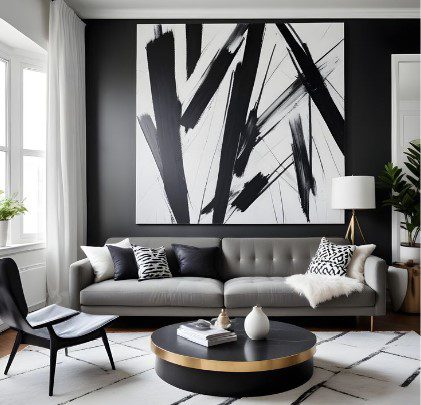
Source: Abstracted Vibe Home Decor (Pinterest)
Vary paint finishes
Using different paint finishes is a smart way to elevate a monochromatic colour scheme. By mixing matte, satin, and glossy finishes, you can create subtle contrasts and enhance the visual depth of your space. For example, you could apply a matte finish on the walls, a satin finish on the furniture, and a glossy finish for accent elements like trims or cabinetry. This variation not only brings texture but also adds a sophisticated touch to the room, allowing light to interact differently with each surface. It keeps the room from feeling too uniform while staying true to the monochromatic theme.
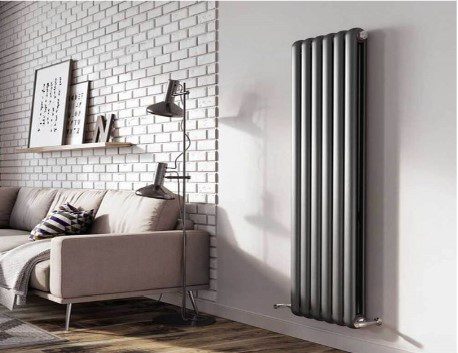
Source: Tap Warehouse (Pinterest)
Add depth with accent pieces
Incorporating accent pieces is a key strategy to add depth to a monochromatic colour scheme. Items such as cushions, rugs, artwork, or vases in darker or lighter shades of your chosen base colour can break the monotony and enhance the overall aesthetic. By thoughtfully placing these accents, you can highlight specific areas of the room, making the design more dynamic and layered. Metallic or glass elements, even in neutral tones, can also complement the monochromatic palette while introducing a touch of elegance and sophistication.
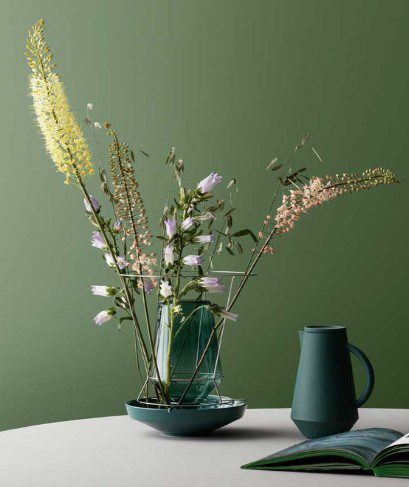
Source: EclecticTrends (Pinterest)
Incorporate lighting to enhance spaces
Lighting plays a crucial role in elevating a monochromatic colour scheme by highlighting different shades and textures within the room. Natural light can enhance the softness of lighter tones, while strategically placed artificial lighting, such as lamps, sconces, or pendant lights, can bring out the richness of deeper hues. Consider using warm or cool lighting to complement the undertones of your base colour. Layering different types of lighting, like ambient, task, and accent lighting, will add depth and dimension, making the space feel balanced and visually appealing.
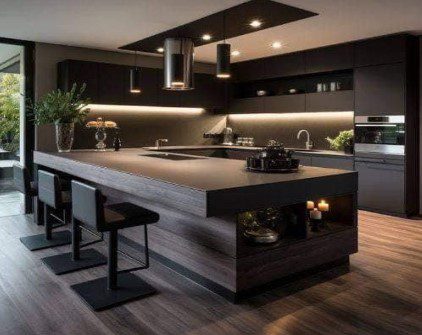
Source: Pinterest
Balance the look
Achieving balance is key when working with a monochromatic colour scheme to ensure the space doesn’t feel flat or overwhelming. Start by distributing different shades of your chosen base colour evenly throughout the room, using darker and lighter tones to create contrast. Avoid overloading the space with one single shade by incorporating a variety of textures, finishes, and materials. Balance can also be maintained by thoughtfully combining furniture, accessories, and decor pieces. Keep larger surfaces like walls and floors in neutral tones, while introducing depth and interest with accent furniture and decorative elements in different shades of the base colour.

Source: ArtAsync.com (Pinterest)
Match walls, trims and ceilings
For a seamless and cohesive look in a monochromatic space, consider matching the walls, trims, and ceilings with the same or similar shades of your base colour. This creates a smooth visual flow, making the room appear more expansive and unified. When the ceiling and trims are painted in the same tone, it minimises sharp contrasts, giving the room a more open and sophisticated feel. If you’re aiming for subtle variation, try using a slightly lighter or darker hue of the base colour for the trim to maintain a harmonious look without losing definition.

Source: The Full Hearted Home (Pinterest)
Add mirrors and reflections
Incorporating mirrors and reflective surfaces is a great way to enhance the impact of a monochromatic colour scheme. Mirrors help bounce natural and artificial light around the room, creating a brighter and more open space. They also add depth and dimension to the area, preventing a monochromatic palette from feeling flat or overwhelming. Reflective materials, such as glossy finishes, metallic accents, or glass surfaces, further amplify the light and contribute to a modern, polished look. Strategically placing mirrors can also highlight focal points, making the space feel more dynamic.
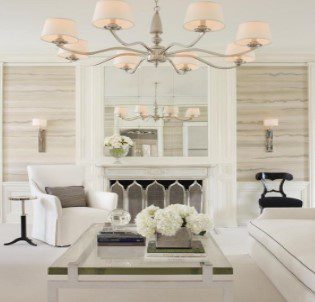
Source: The Ace of Space Blog (Pinterest)
Add final touches
Final touches play a crucial role in completing a monochromatic colour scheme and bringing your space to life. Consider incorporating decorative elements that complement your chosen colour palette, such as artwork, throw pillows, rugs, or vases. These accessories can introduce subtle variations in tone and texture, enhancing the overall aesthetic without disrupting the monochromatic harmony. Additionally, adding greenery through indoor plants can infuse a fresh touch and vitality into your space, creating a beautiful contrast while maintaining the colour scheme. Finally, don’t forget to consider personal items or heirlooms that reflect your personality, as they can add warmth and character, making your monochromatic space uniquely yours.

Source: Marla Sýmone (Pinterest)
Gorgeous monochromatic colour room design ideas for home
Exploring stunning design ideas can inspire you to incorporate monochromatic colour schemes into various areas of your home. Here are some fresh and stylish examples to consider for each room, showcasing how different colours can create a cohesive and visually appealing environment.
Monochromatic living room designs
Creating a monochromatic living room can elevate the space, making it feel both cohesive and sophisticated. To achieve this look, start by selecting a base colour that resonates with your style. A soothing grey or calming beige can create a serene atmosphere, while a bold navy or vibrant red can add a dramatic flair. Incorporate various shades and tints of your chosen color to add depth and interest.

Source: Bored Panda (Pinterest)
For instance, if you opt for blue, consider mixing navy upholstery with lighter blue throw pillows and accent pieces in white and light grey. Textures play a crucial role in a monochromatic living room; combine plush fabrics like velvet or wool with sleek surfaces such as glass or metal.
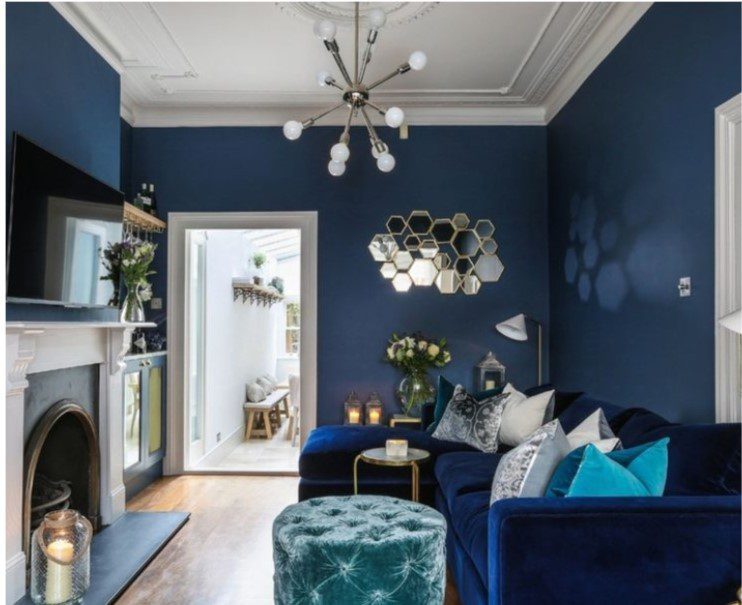
Source: Fashion (Pinterest)
Lighting is also vital in enhancing a monochromatic living room. Use a combination of ambient lighting, such as ceiling fixtures, and accent lighting, like table lamps, to create layers and highlight specific areas. Don’t forget to accessorise with unique pieces—like a statement coffee table or textured rugs—that complement your colour scheme and bring the room together.
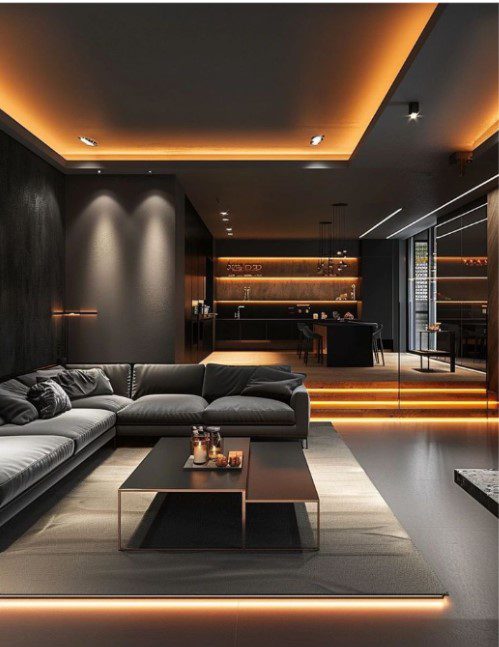
Source: Elegantgene (Pinterest)
By focusing on patterns, such as striped or geometric designs, you can add visual interest without straying from the monochromatic theme. Remember to balance the room by distributing your colour choices evenly, creating a harmonious and inviting space.

Source: House Diamond (Pinterest)
Monochromatic bedroom designs
Designing a monochromatic bedroom can foster a peaceful and restful environment, ideal for relaxation and rejuvenation. Start with a calming base colour, such as soft lavender or muted green, to promote tranquillity. Then, layer different shades of the same colour throughout the space to create a serene ambiance.
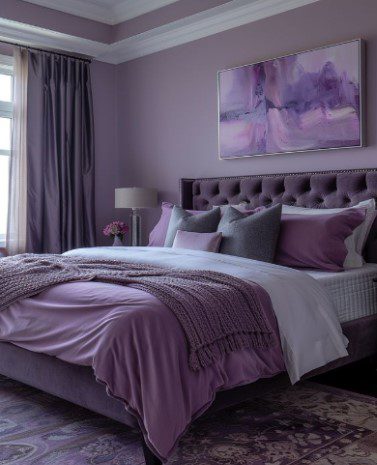
Source: My Elegant Home (Pinterest)
For example, in a bedroom designed around a gentle grey, consider using light grey bedding paired with darker grey curtains and accents. This layering creates depth and keeps the space from feeling flat. Incorporating various textures is essential; combine smooth silk pillows with a chunky knit blanket or a plush shag rug to add comfort and warmth.

Source: Kyōto Home (Pinterest)
Don’t underestimate the power of lighting in a monochromatic bedroom. Use soft bedside lamps to create a cosy atmosphere, and consider adding dimmers to overhead lights for adjustable ambiance. Accent pieces, such as decorative cushions or artwork, should align with your colour scheme but can introduce subtle patterns to add interest without overwhelming the space.
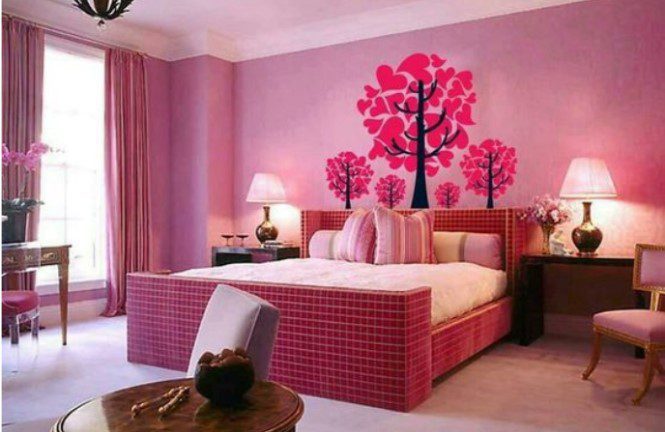
Source: Pinterest
The key to a successful monochromatic bedroom design is balance. Ensure that your colour distribution is even, and consider matching walls, bedding, and furniture for a cohesive look. Lastly, incorporate personal touches—like photographs or unique decor items—that reflect your style while maintaining the monochromatic aesthetic. This creates a space that is not only stylish but also feels uniquely yours.
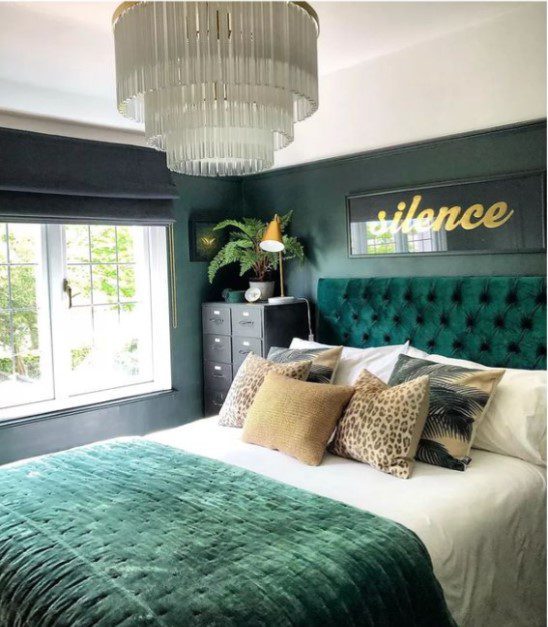
Source: Mydomaine (Pinterest)
Monochromatic bathroom designs
Designing a monochromatic bathroom allows you to create a sleek, sophisticated, and spa-like atmosphere that elevates your daily routine. By selecting a single colour palette, you can unify various elements of the space, making it appear more spacious and cohesive.
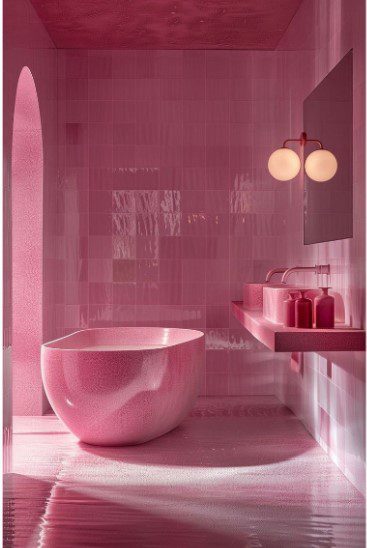
Source: My Elegant Home (Pinterest)
For instance, consider using shades of soft white for a clean and airy feel. You might opt for white tiles on the walls and floor, paired with a white vanity and fixtures. To add interest, play with different textures, such as a matte finish on the walls and glossy accents on the cabinetry. Incorporating a fluffy white bath mat or towels in varying textures can also enhance the comfort level while maintaining the colour theme.

Source: Designthusiasm (Pinterest)
Alternatively, if you prefer a bolder look, consider deep navy or charcoal for a dramatic effect. Paint the walls in a rich navy hue and choose dark cabinetry. You can introduce lighter elements, such as white towels or a freestanding tub, to create contrast and visual balance.
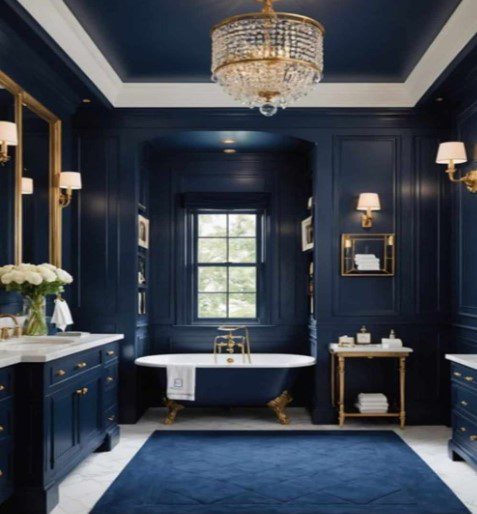
Source: West Magnolia Charm (Pinterest)
Accent pieces like mirrors, artwork, or decorative accessories in varying shades of the chosen colour can further enhance the monochromatic look. A strategically placed plant can introduce a hint of greenery while still aligning with the overall colour scheme. The result is a bathroom that feels cohesive, stylish, and tailored to your preferences, making it a delightful retreat for relaxation and rejuvenation.
Monochromatic kitchen designs
A monochromatic kitchen design can transform a functional space into a stunning culinary haven. By employing varying shades of a single colour, you can achieve a harmonious look that enhances the kitchen’s visual appeal while ensuring it remains practical and inviting.

Source: AIHomeDesign (Pinterest)
One popular approach is to use shades of white for a bright and airy kitchen. Consider white cabinetry paired with white countertops and backsplash tiles. To add depth, introduce elements like textured white brick or patterned tiles. Accessories such as white dishware and glass containers can also contribute to the overall aesthetic, creating a clean, cohesive look.

Source: DIY Bunker (Pinterest)
For those who prefer a bolder statement, a monochromatic black kitchen can exude elegance and sophistication. Black cabinets, countertops, and even appliances can be combined to create a sleek, modern vibe. Adding glossy finishes or metallic accents can introduce a touch of glamour, while strategically placed under-cabinet lighting can illuminate the space, creating an inviting atmosphere.
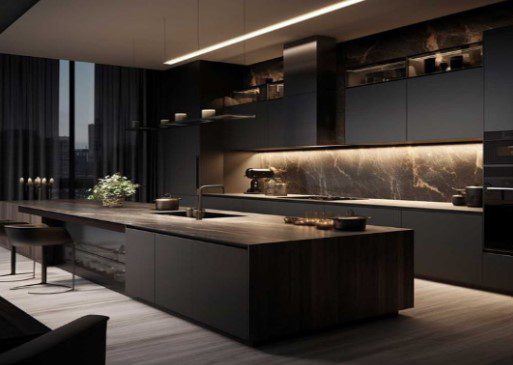
Source: 333k+ Arts (Pinterest)
You can also explore warmer tones like beige or cream for a welcoming, cosy feel. Beige cabinets combined with cream walls and natural wood accents can evoke a sense of warmth and comfort. Introducing wooden shelves or a wooden dining table can further enhance this cosy aesthetic while maintaining the monochromatic theme.
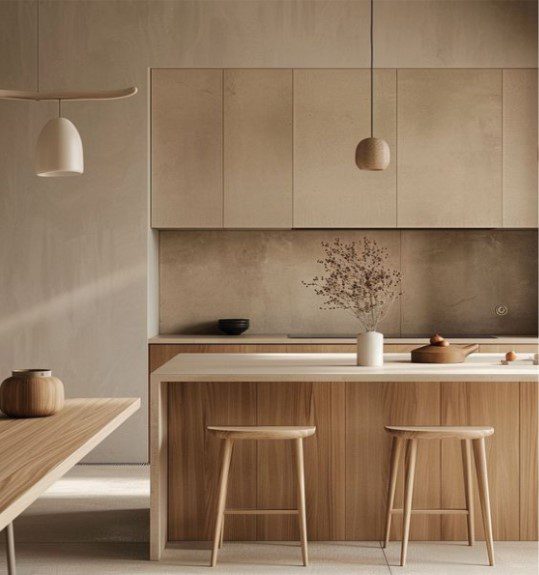
Source: Hygge and Home (Pinterest)
Regardless of the colour chosen, incorporating varying textures through materials like metals, wood, and fabrics is key. This adds interest and dimension to the space, ensuring the kitchen feels dynamic while still adhering to the monochromatic scheme. With thoughtful design choices, your monochromatic kitchen can become a stylish and functional centrepiece of your home.
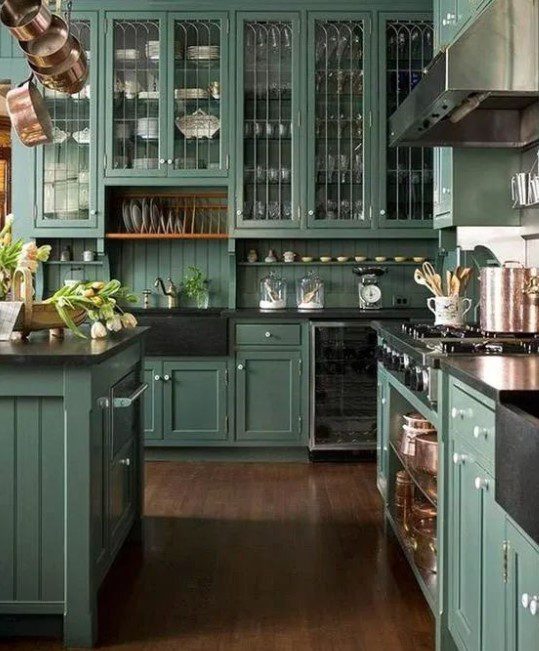
Source: Jessica Brigham (Pinterest)
Monochromatic dining room designs
A monochromatic dining room design can create an inviting and cohesive atmosphere, perfect for entertaining guests or enjoying family meals. By choosing a single colour and its various shades, you can achieve a sophisticated and stylish look that enhances the dining experience.

Source: Alicia Britt Woodle (Pinterest)
One popular approach is to use shades of deep blue or navy, which can add a touch of elegance and depth to the space. Consider deep blue walls paired with matching blue dining chairs and a wooden table. Accentuate the look with white dinnerware or glassware to create a stunning visual effect. Adding metallic accents, such as gold or silver cutlery and candle holders, can introduce a sense of luxury, enhancing the overall ambiance.

Source: HomeDesignsAI (Pinterest)
For a more serene and calming vibe, shades of green are an excellent choice. Deep mint green walls can be paired with matching upholstery on dining chairs. A polished wooden dining table adds warmth to the space and contrasts beautifully with the green tones. Incorporating greenery through potted plants or a floral centrepiece can also enhance the monochromatic theme while promoting a fresh, lively atmosphere.
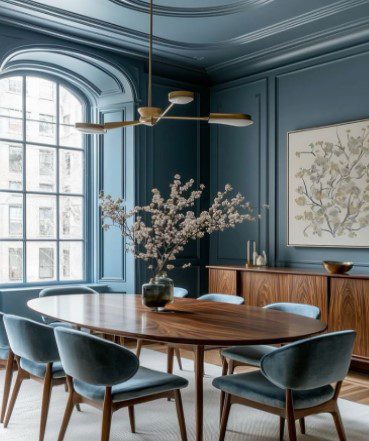
Source: Pinterest
If you prefer a more dramatic approach, consider a monochromatic black-and-white dining room. White walls can be complemented by a sleek black dining table and chairs, creating a bold statement. Incorporating black and white art pieces or a patterned rug can add visual interest and sophistication to the room. To soften the look, add natural elements such as wooden accents or greenery, which can help create a balanced atmosphere.

Source: Williams Sonoma (Pinterest)
Finally, using soft neutrals like beige or taupe can create a warm and inviting dining environment. These shades can be used on walls, furniture, and accessories, promoting a cosy feel. Adding textures through fabrics, such as a plush tablecloth or upholstered chairs, can further enhance the warmth and comfort of the space.

Source: Maison Rêves UK (Pinterest)
By thoughtfully selecting and layering shades of a single colour, you can transform your dining room into a stylish and welcoming space that reflects your personal style and enhances the dining experience.
Housing.com POV
Incorporating monochromatic colours into your home can transform your space, creating a sense of harmony, sophistication, and depth. By understanding the various shades, undertones, and textures associated with a monochromatic colour scheme, you can craft a visually stunning environment that reflects your personal style. Whether you choose calming blues, vibrant yellows, or elegant creams, the key lies in layering different shades and textures to create balance and interest. As you implement the tips and design ideas discussed, remember to start small and gradually build upon your monochromatic vision. By paying attention to the finer details—such as lighting, patterns, and accent pieces—you can elevate your space from ordinary to extraordinary. Embrace the beauty of monochromatic design and let your creativity shine as you transform your home into a cohesive and inviting sanctuary.
FAQs
Can I use a monochromatic colour scheme in small spaces?
Yes, a monochromatic colour scheme can make small spaces feel larger and more cohesive. Lighter shades create an airy feel, while darker hues add depth. Just ensure to incorporate varied textures for interest.
How do I choose a base colour for my monochromatic scheme?
Consider your personal preferences and the mood you want to create. Analyse the existing elements in the space, such as furniture and decor, and choose a base colour that complements or enhances those features.
What are some common mistakes to avoid when using monochromatic colours?
Common mistakes include choosing shades that are too similar, resulting in a flat look, or neglecting texture and patterns, which can create a dull atmosphere. Balance and variation are key for a vibrant space.
How can I update a monochromatic room without repainting?
You can refresh a monochromatic room by changing accessories like cushions, throws, artwork, and rugs. Introduce different textures or patterns, or even swap out furniture to give the space a new feel.
Are monochromatic colour schemes suitable for all design styles?
Yes, monochromatic colour schemes can be adapted to various design styles, from modern and minimalist to traditional and eclectic. The key is to choose shades and textures that align with your overall aesthetic vision.
Got any questions or point of view on our article? We would love to hear from you. Write to our Editor-in-Chief Jhumur Ghosh at jhumur.ghosh1@housing.com
Was this article useful?
? (0)
? (0)
? (0)

Dhwani is a content management expert with over five years of professional experience. She has authored articles spanning diverse domains, including real estate, finance, business, health, taxation, education and more. Holding a Bachelor’s degree in Journalism and Mass Communication, Dhwani’s interests encompass reading and travelling. She is dedicated to staying updated on the latest real estate advancements in India.
Email: dhwani.meharchandani@housing.com




